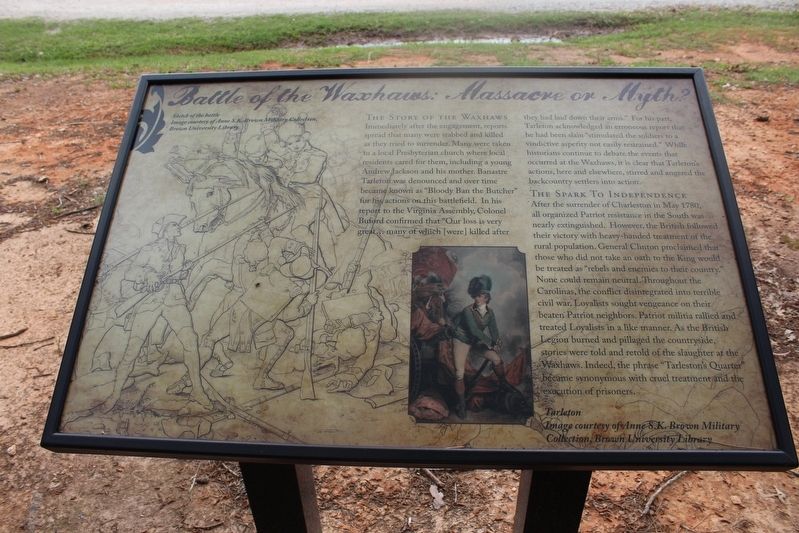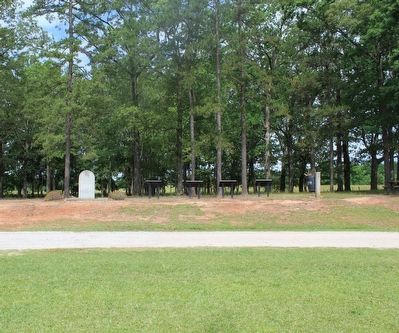Near Buford in Lancaster County, South Carolina — The American South (South Atlantic)
Battle of the Waxhaws: Massacre or Myth?
Immediately after the engagement, reports spread that many were stabbed and killed as they tried to surrender. Many were taken to a local Presbyterian church where local residents cared for them, including a young Andrew Jackson and his mother. Banastre Tarleton was denounced and over time became known as "Bloody Ban the Butcher" for his actions on the battlefield. In his report to the Virginia Assembly, Colonel Buford confirmed that "Our loss is very great … many of which (were) killed after they had laid down their arms." For his part, Tarleton acknowledged an erroneous report that he had been slain "stimulated the soldiers to a vindictive asperity not easily restrained." While historians continue to debate the events that occurred at the Waxhaws, it is clear that Tarleton's actions, here and elsewhere, stirred and angered the backcountry settlers into action.
The Spark to Independence
After the surrender of Charleston in May 1780, all organized Patriot resistance in the South was nearly extinguished. However, the British followed their victory with heavy-handed treatment of the rural population. General Clinton proclaimed that those who did not take an oath to the King would be treated as "rebels and enemies to their country." None could remain neutral. Throughout the Carolinas, the conflict disintegrated into terrible civil war. Loyalists sought vengeance on their beaten Patriot neighbors. Patriot militia rallied and treated Loyalists in a like manner. As the British Legion burned and pillaged the countryside, stories were told and retold of the slaughter at the Waxhaws. Indeed, the phrase "Tarleton's Quarter" became synonymous with cruel treatment and the execution of prisoners.
Topics. This historical marker is listed in this topic list: War, US Revolutionary. A significant historical date for this entry is May 29, 1780.
Location. 34° 44.51′ N, 80° 37.566′ W. Marker is near Buford, South Carolina, in Lancaster County. Marker can be reached from Rocky River Road (State Highway 522) 0.2 miles south of Pageland Highway (State Highway 9), on the right when traveling south. This marker is located at the Buford Battleground Monument Park (Buford Massacre Site). Touch for map. Marker is in this post office area: Lancaster SC 29720, United States of America. Touch for directions.
Other nearby markers. At least 8 other markers are within walking distance of this marker. Buford's Massacre (here, next to this marker); Buford's Defeat (here, next to this marker); Buford Battleground (here, next to this marker); Disaster in South Carolina (a few steps from this marker); Honoring The Fallen (a few steps from this marker); Buford Monument (a few steps from this marker);
Memorials and Archaeology (within shouting distance of this marker); Buford's Bloody Battleground (approx. 0.2 miles away). Touch for a list and map of all markers in Buford.
More about this marker. The marker is the third of four markers that interpret Buford's Massacre and preservation of the site.
Regarding Battle of the Waxhaws: Massacre or Myth?. At left is a "Sketch of the Battle." At bottom is a painting of "Tarleton." Both images are courtesy of Anne S.K. Brown Military Collection, Brown University Library.
Additional commentary.
1. The Buford Monument
The Memorial at the Battle of Buford is not simply a marker. It bears the names of all of Colonel Buford's men who according to the story were slaughtered by the British as they waved the flag of truce. There is also a very somber reminder of the battle that historians say took less than 15 minutes, a large mass grave with the bodies of eighty some odd soldiers and some of their mounts. Standing in that place over the mass grave and imagining the horrors that went on during that 15 minutes, it is understandable why "Remember Tarleton's Quarters" became a battle cry and a spark to the American Revolution!
— Submitted April 20, 2020, by Herman Eldridge Floyd of Lancaster, South Carolina.
Credits. This page was last revised on April 27, 2020. It was originally submitted on July 1, 2016, by David Graff of Halifax, Nova Scotia. This page has been viewed 1,025 times since then and 39 times this year. Photos: 1, 2. submitted on July 1, 2016, by David Graff of Halifax, Nova Scotia.

